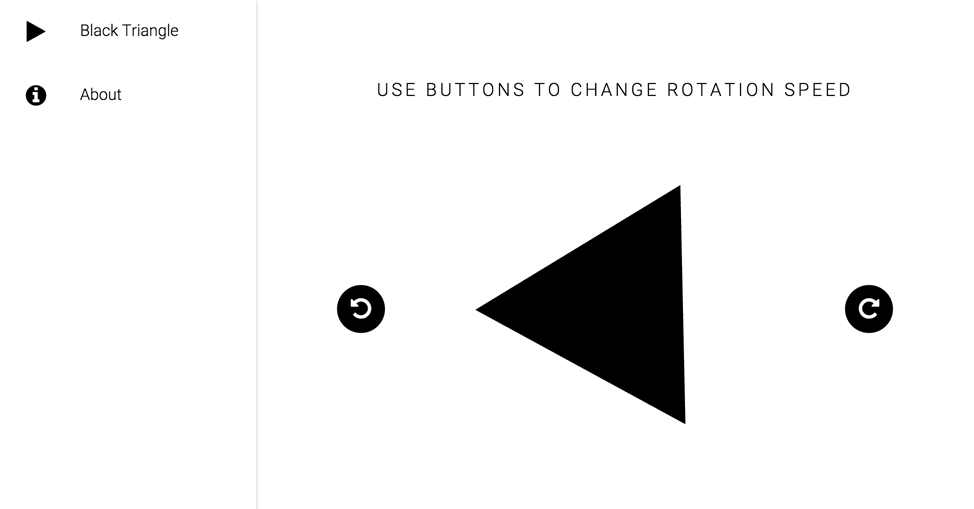HELLO: react-black-triangle (and Maxim) are at v0.1 - if you find this neat, you can help make it even better by letting me know where you'd like to see more documentation!
react-black-triangle provides you with the code and conventions you need to get straight into building your React-based app.
Prerequisites: node.js and git
git clone [email protected]:jamesknelson/react-black-triangle.git [your-repo-name]
cd [your-repo-name]
npm install
npm install -g gulp
npm start
npm run open # (from a different console window, otherwise open localhost:3000)
Presto, Black Triangle!
- Your directory structure is sorted as soon as you
git clone - ES6 compilation and automatic-reloading development server are all handled by
npm start - Maxim (based on RxJS) makes your data flow easy to reason about
- CSS conventions and helper functions completely eliminate bugs caused by conflicting styles
- Elegant routing is included without depending on the confusing
react-router - A simple layout is included to help you get started on the important stuff right away
- Comes with a cool spinning Black Triangle - how fucking awesome is that?!
Put your name on it:
- Update name and author in package.json
- Update app title in
src/index.html - Restart the dev server (make sure to do this after any changes to
src/index.html)
Make sure your editor is happy
- Setup ES6 syntax highlighting on extensions
.jsand.jsx(see babel-sublime)
Remove the stupid black triangle and any references to it:
BlackTriangleControlBlackTriangleModelAnimatorActorBlackTrianglePage
Start building!
- Add a route to
src/utils/router.js - Add a nav menu item in
src/components/NavMenu/NavMenu.jsx - Add a component for it in
src/components - Add the new component and route to
src/components/Application.jsxandsrc/theme/theme.less - Bask in the glory of your creation
- Don't forget to commit your changes and push to bitbucket or github!
Show your friends
- Run
gulp distto output a web-ready build of your app todist
Your data - including routes, authentication, view model data, and anything else you can imagine - is managed by Maxim.
Maxim is similar to Facebook's Flux, in that data flow is unidirectional. Events start at your Controls, then flow through your Models, Reducers, Actors, and finally through your Components to the user's screen.
Maxim gives you four classes with well defined responsibilities:
All possible actions which can affect the state of your model are defined in these Controls.
Each control file defines a number of action functions. Action functions can do things which change the outside world (like making HTTP requests or setting timers), and can call other actions in the same control module (as long as the calls are in a separate tick).
Once an action has run any necessary code, it should call this to emit an event to be processed by model modules.
Models take the Rx.Observable objects from the above action files as inputs. Each model returns a single observable itself, which represents the state of that model.
Reducers take the Rx.Observable objects produced from models and other reducers, and further process them into more Rx.Observables.
Actors subscribe to the Rx.Observable objects from your Model and Reducer files, using the result to change the outside world through actions such as displaying a UI or calling further control actions.
Of course, having an actor which is called with the latest version of your data is only half the problem - you need to effectively communicate this data to your users. We accomplish this with (surprise!) React!
To help concenctrate on actually building your application, use these conventions when building your user interface:
UserInterfaceActorrenders theApplicationcomponent every time any model/reducer data changes- Components should access control actions through their
this.context.Actionsproperty (seeBlackTrianglePage.jsxfor an example) - Data should be passed as props, and not passed through
context. - Make sure each of your components have their own directory under
src/components(other than the specialApplication,BaseandLinkcomponents). - Each component should inherit from the Base component (which provides helpers for genrating classes, see
src/components/Base.jsxfor documentation) - Control Actions are
-
Each component's root element should have a class named after the component itself
-
Each component should accept a
classNameprop which adds any specified classes to it's own classes -
Style selectors should always be a single class, and optionally a pseudo-selector. For example:
.NavMenu .Linkis bad.NavMenu-itemis good
The
this.cmethod on every component which inherits from base helps with making these methods.
Maxim directories:
src/controls- Eachcontrolcontains actions which can be called by actorssrc/models- Eachmodelmaintains a single value, updating it based on control eventssrc/reducers- Further process the values of models and other reducerssrc/actors- Interfact with the world based on changes to your model
UI directories:
src/components- React components and their associated stylesheetssrc/theme- Global CSS (you generally don't put anything here except imports for component stylesheets)
Other directories:
build- Intermediate files produced by the development server. Don't touch these.src/utils- Pure functions which you may want to use across your entire project go heresrc/static- Files which will be copied across to the root directory on build
Individual modules (documentation coming soon):
src/actors/UserInterfaceActor.jsxsrc/components/Application.jsxsrc/components/Base.jsxsrc/components/Link.jsxsrc/controls/NavigationControl.jssrc/models/NavigationModel.jssrc/theme/theme.lesssrc/utils/router.jssrc/index.htmlsrc/main.js
And other files:
- Watch
staticandindex.htmlfor changes and copy them across tobuildwhen appropriate
